How to Grow a Garden You’ll Actually Use
This post may contain affiliate links, including those from Amazon.com, which means we earn a small commission off your purchases. And here's the thing: We only mention services and products that we think are truly worth your attention, whether they're free, paid, or otherwise. This site relies on YOUR trust, so if we don't stand behind a product 110%, it's not mentioned. Period.
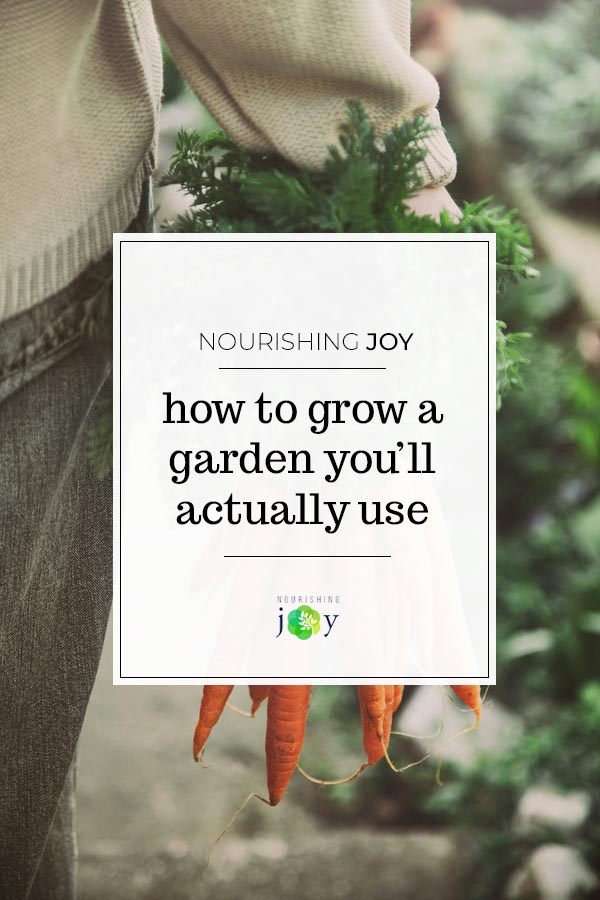


Growing your own food is a BRILLIANT way to eat deeply nourishing food, ensure your food is free of pesticides and GMO's, and save significant money on your groceries.
But many people who are totally excited about the idea of growing their own food are also totally overwhelmed at knowing how to start or knowing what to grow.
Or you're like me and get so excited as you pour over seed catalogs each spring that you end up planting way too many varieties and come August, there's too much food to deal with!
So, how about this: forget what you think you should grow, and grow only what you'll use over and over and over again all season long.
For example, I love our morning green smoothies, but it gets expensive FAST if I only use store-bought frozen fruit – like pineapple, mango, and berries – and if I buy all our kale. So, by getting a little creative with our recipes, I can grow most of what we use in our smoothies and just supplement with a few of our favorite tropical fruits.
Also, it used to be common on farms and manors that not only would the family grow a garden to store food for winter, but they also had a “kitchen garden,” which was a smaller garden right next to the kitchen door where the foods that were used for every day food prep, like onions, herbs, and common vegetables, were grown.
I love this idea of growing what you'll harvest small amounts of every day, rather than trying to plan a full garden of what you think a garden *should* have.
I also love that these gardens are very sizeable. You can grow all you need in a windowbox (even indoors), a container garden (even if your space is very, very small), or in a full-acre plot.
However much space you have is pretty much all you need. And even better, right now is the perfect time to plant it!
So here are a few ideas to get you started on planning, planting, and growing a garden that's just right for YOU (no matter whether you want a garden to save money or if you just want a garden that will attract the prettiest birds.)

Please note – this post is a plant planning guide, meant to help you think critically about what you would realistically benefit from growing in your own garden this year.
This post is NOT a how-to gardening guide, as growing needs and methods range widely from region to region and to include information about each plant would make this guide unwieldy, so use it as a creative springboard and search out specific planting methods if you need them.
But first, SOIL… and a few supplies…
As always, use what you already have on hand first and foremost! This will save you beaucoups bucks and make good use for items you already have sitting around.
However, here are a few suggestions if you're just getting set-up.
1. Homemade Potting Soil
For more detailed info, read our short guides on how to make homemade potting soil and how to make homemade root stimulant.
If you're using containers of any kind, you'll want an excellent soil. Soil is the heartbeat, the food, and the home of the plant, so it needs to be good – no, make that great. I've killed many a plant because I didn't give it a good home, quite literally. My farmer husband has taught me a few things since then, thank goodness. 🙂
Basically, a great homemade potting mix is to mix equal parts of vermiculite (or perlite), peat moss (or coconut coir), and high-quality finished compost (or worm castings).
If you can't find the ingredients you need locally, here are a few good options:
- Click to find vermiculite.
- Click to find perlite.
- Click to find peat moss.
- Click to find coconut coir.
- Click to find finished compost.
- Click to find worm castings.
2. How to Make a DIY Self-Watering Wicking Bed Planter Box
If space is limited, a planter box is the way to go – and a self-watering wicking bed planter box is absolutely the BEST way to go, as containers are notorious for drying out super-quickly, but a wicking bed variety basically self-waters.
Here's a great video from Pacific Permaculture showing how to make a DIY wicking bed planter box or you can purchase a pre-made planter box for about $60.
3. The Art of Gardening: Building Your Soil
If you're new to gardening, are a long-time lover of gardening, or just love beautiful things done well, this e-book, The Art of Gardening, is a drool-over, absolutely inspirational book for every garden- or food-lover. Check it out here.
How to Grow a Garden You'll Actually Use
Okay – let's get gardening!
How to Grow a Salsa Garden
Read more: Get our perfect restaurant-style salsa recipe.
What to Plant
- Tomatoes – choose meaty, full-flavored ones, such as Romas, San Marzanos, Amish Pastes, Beefsteaks, or Brandywines
- Cilantro – plan to plant this every 2-3 weeks through the summer so you're never without (it wilts quickly in the heat and can go to seed within days, so you'll want a fresh supply)
- Hot Peppers – plant a mix: jalapeños for sure, serranos or anaheims for heat and flavor, habañeros for extreme heat, and poblanos if you want to roast some of the peppers for a smoky, chipotle note to your salsa
- Spanish or White Onions – these can be planted either in the fall for overwintering, in the mid-spring, or along with all your other plants. They take much longer to germinate and grow to their full maturity, though, so an early planting is a good idea, if possible.
- Garlic – this will need to overwinter, so plan to plant garlic in the fall
Optional Plants You Might Want to Consider (if they can grow where you live!)
- Limes
- Tomatillos
- Bell Peppers
- Pineapple
- Mango
- Corn
- Avocadoes
Click to find a ready-to-plant salsa garden seed kit here.
How to Grow a Smoothie Garden
This one is highly subjective to what you like to put in your smoothies. I'm listing as suggestions common smoothie/juicing foods, but obviously, if you find yourself buying something regularly for your smoothies that you can grow in your climate, definitely add it to your planting list!
Even if you only grow your kale and spinach, you'll save plenty!
What to Plant
- Berries – strawberries, blackberries, and raspberries are easiest, but blueberries, cranberries, and honeyberries are also great options
- Other fruits – cherries, pears, plums, and kiwis (find a hardy kiwi that grows in cooler climates, if needed!)
- Kale – curly kale and Russian kale are my favorites for smoothies
- Spinach
Optional Plants You Might Want to Consider (if they can grow where you live!)
- Grapes
- Watermelon, honeydew, and other melons
- Peaches/Apricots
- Oranges & grapefruit
- Mangoes
- Bananas
- Pineapples
- Mint
- Carrots
How to Grow a Pizza Garden
What to Plant
- Tomatoes – plum style are best for sauce-making and are hold together well if you chop them to have fresh tomatoes on top of the pizza
- Sweet bell peppers – planting all colors will make your pizzas delightfully colorful
- Vegetables your family loves – zucchini, eggplant, and even beets make gorgeous pizza toppings
- Onions – red onions for toppings, yellow onions for the sauce
- Oregano
- Basil
- Garlic – lots and lots of garlic! (this will need to overwinter, so plan to plant it in the fall)
Optional Plants You Might Want to Consider (if they can grow where you live!)
- Green onions/scallions
- Corn
- Olives
- Artichokes
- Wheat – plant a patch of non-modern wheat, use a wheat grinder, and make your own flour for your homemade pizza dough (for the extreme DIYers 🙂 )
Find a ready-to-plant pizza garden seed kit specifically for kids here.
Want more homemade pizza ingredients?
My favorite classic recipes for both pizza crust and pizza sauce can be found in my book of homemade pantry staples, The DIY Pantry, but if you're wanting recipes NOW and don't have time to get the book, these are excellent options:
Homemade Pizza Crust – This is my favorite sourdough pizza crust and here's a “regular” homemade pizza crust. That last link also has a lovely homemade pizza sauce.
You can find other homemade versions, including how to brine your own olives, on our homemade pantry staples Pinterest board.
How to Grow a Culinary Herb Garden
Herbs make all the difference, whether you're adding them to a dish or tossing them on a salad. Fresh herbs make everything fresh!
What to Plant
- Basil
- Oregano
- Chives
- Dill
- Parsley – both curly and flat-leaf (Italian)
- Cilantro
- Sage
- Rosemary
- Thyme
- Tarragon
- Mint
Optional Plants You Might Want to Consider (if they can grow where you live!)
- Lovage
- Marjoram
- Savory
- Coriander
- Sweet Bay
Find a ready-to-plant culinary herb garden seed kit here.
How to Grow a Medicinal Herb Garden
What to Plant
- Garlic
- Chamomile
- Lavender
- Echinacea
- Lemon Balm
- Rose Hips
- Aloe Vera
- Stinging Nettles
- Elder tree/elder bush
- Ginseng
- Yarrow
- Comfrey
- Mullein
- Plantain
Optional Plants You Might Want to Consider (if they can grow where you live!)
- Willow
- Dandelion
- Goldenseal
- Licorice
- Motherwort
- Marshmallow Root
- Tea Tree
- Fenugreek
- Blessed Thistle
If you can't find seeds or cuttings for any of the above herbs, nearly all of them can be found at Mountain Rose Herbs and at West Coast Seeds.
Also, find a ready-to-plant medicinal garden seed kit here (the herbs included are a bit different than I've recommended above, but they're excellent!)
How to Grow a “Kitchen Garden”
A kitchen garden is all about what you use regularly, so if your family uses other ingredients regularly (say, turmeric or cumin), for sure add them in!
What to Plant
- Garlic – this will need to be overwintered, so start them in the fall
- Onions
- Basil
- Oregano
- Chives
- Parsley
- Cilantro
- Sage
- Rosemary
- Thyme
- Dill
- Mint
- Cucumbers
- Sweet peppers
- Kale – curly kale and lacinato kale (also known as Tuscan kale, dinosaur kale, or black kale)
- Swiss chard
- Lettuce – my favorites are romaine and butterleaf
- Summer squash – zucchini, eggplant, etc
- Tomatoes
- Potatoes
Optional Plants You Might Want to Consider (if they can grow where you live!)
- Carrots
- Celery
- Lovage
- Bush green beans
- Peas
- Corn
How to Grow a Tea Garden
Black, green, and white teas all come from the Camellia Sinensis plant, which you CAN grow in various places around the world. In fact, you can purchase the Camellia Sinensis plant right here. This is one of the plants I'm *most* excited to be growing this year, even in my somewhat northern climes. I recommend planting at least three bushes, both so you can easily harvest as often as you wish without over picking the leaves and so there can be cross-pollination as needed.
However, there are easier ways to grow your own tea, as you can brew tea from nearly any plant. There are teas from leaves, tea from fruit, tea from buds or flowers, tea from roots, and tea from seeds. Cassie Liversidge's book, Homegrown Tea, is a fantastic resource for this if you're serious about growing your own tea – including black, green, and white, not just herbal!
(That said, herbs are by far the easiest to source and grow!)
What to Plant
- Anise Hyssop
- Mint
- Chamomile
- Lemon Balm
- Lemon Mint
- Rose Hips
- Echinacea
- Rosemary
- Catnip
- Wild Bergamot
- Ginger root
- Turmeric
Optional Plants You Might Want to Consider (if they can grow where you live!)
- Blackberry
- Raspberry
- Roses – you can brew either fresh petals or dry rosebuds
- Lavender – I love to add just a few blossoms to pretty much any other tea
- Oranges, lemons, and other citrus – to use fresh and to dry the rinds
Find a ready-to-plant herbal tea garden seed kit here.
Find instructions on how to brew a perfect cup of tea from fresh herbs here.
And again, if you REALLY want black, green, or white tea, you can purchase the Camellia Sinensis plant here.
I have not been able to find a source to purchase a rooibos bush or a honeybush plant outside of South Africa. If anyone knows of a reputable source for those in North America, please let me know!
How to Grow a Garden for Preserving
This garden is grown for the sake of preserving and setting food aside for the winter.
Read our mega-article on How to Preserve {Pretty Much} Anything.
What to Plant
- Herbs (to dry) – all the herbs listed above in the “Kitchen Garden” are perfect for drying
- Onions and shallots (to dry)
- Garlic (to dry)
- Winter Squash – pumpkin, butternut, spaghetti squash, etc (to place into dry storage)
- Potatoes (to place into dry storage)
- Pickling cucumbers (be sure to plant dill!)
- Tomatoes – lots and lots of tomatoes for drying, saucing, canning, and green tomato mincemeat
- Carrots, beets, and other root vegetables (to place into dry storage or dehydrate)
- Beans (to freeze)
- Bell peppers (to freeze or dehydrate)
- Hot peppers (to freeze or dehydrate)
- Berries and summer fruits (to freeze or turn into jam)
- Summer fruits and autumn fruits (to puree and dehydrate)
- Cabbage (to ferment)
- Broccoli (to freeze)
Optional Plants You Might Want to Consider (if they can grow where you live!)
- Figs (see how to dehydrate figs)
- Mushrooms (see how to dehydrate mushrooms)
- Sweet potatoes (to place into dry storage)
How to Grow a Salad & Greens Garden
Many of these varieties are absolutely delightful if they're cut as baby greens, so plan to plant the lettuces and other greens every 2-3 weeks to keep you supplied.
What to Plant
- Lettuces – butter lettuce, romaine, Bibb, and red leaf are my personal favorites
- Mesclun Mix – a mix containing a number of bitter and sweet greens that grow a delightful, gourmet salad
- Swiss Chard
- Arugula
- Spinach
- Kale – curly kale and lacinato kale are best for salads
- Cucumbers
- Tomatoes – plant a variety and cherry-sized tomatoes are lovely in this kind of set-up
- Beets – these are planted for the greens. The beetroots are eaten at the end of the season as a treat. 🙂
- Fresh herbs – parsley, dill, and tarragon are my favorites for salads
Optional Plants You Might Want to Consider (if they can grow where you live!)
- Radishes (I love French Breakfast)
- Carrots
- Celery
- Broccolini
Find a ready-to-plant salad garden seed kit here.
How to Grow a Christmas Garden
Using fresh evergreen boughs and holly at Christmas is a frugal, cheery way to celebrate the season. Plant a few shrubs and small trees and you'll have fresh boughs every year. If you don't want to plant them outside (or don't have sufficient space), each of these can survive in a very large pot for up to two years.
Read more: “12+ Simple Decorations for a Frugal, Classy, Festive Christmas.”
What to Plant
- Fir tree – keep in mind that in 20 years this will likely be a large tree with a significant root system, so give it PLENTIFUL space if you're planting it in-ground.
- Pine tree – pine cones are a wonderful Christmas decoration, so harvest them right where you are (and the same notes as the fir tree apply!)
- Spruce, juniper, or cedar bush – these semi-flat-leafed boughs are lovely for Christmas table settings
- Holly bush
- Mistletoe – this can spread quickly and become invasive, so a planting in a pot can be a good idea 🙂
Helpful Gardening Resources
RAISED BED GARDENING PLANNER: This fabulous graphic is from Williams-Sonoma's Agrarian site. If you like raised bed gardening or are just looking for a bit of help laying out your beds, definitely visit their site and print out the printables of these images. And as a thank you for letting us use their image, perhaps poke around their site and see if there's anything that could help you this season. 🙂
Also, the site Grow a Good Life is a GREAT resource for all thing gardening and sustainable, so check out her post on How to Grow a Salsa Garden for a start, then explore the site for more inspiration than you'll know what to do with. 🙂
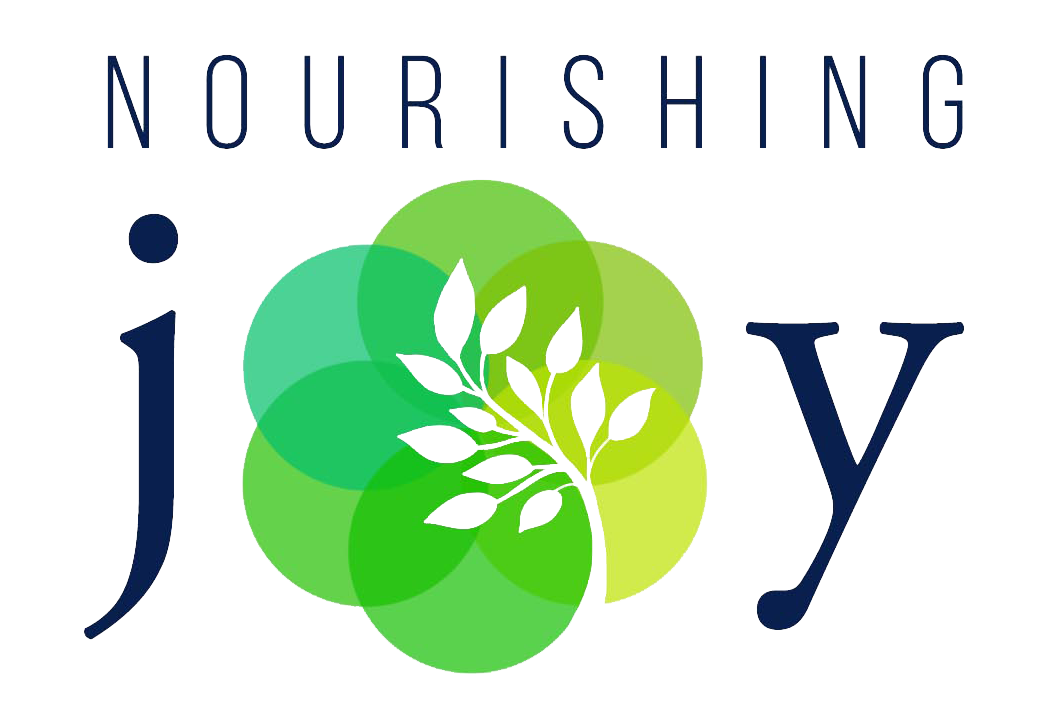
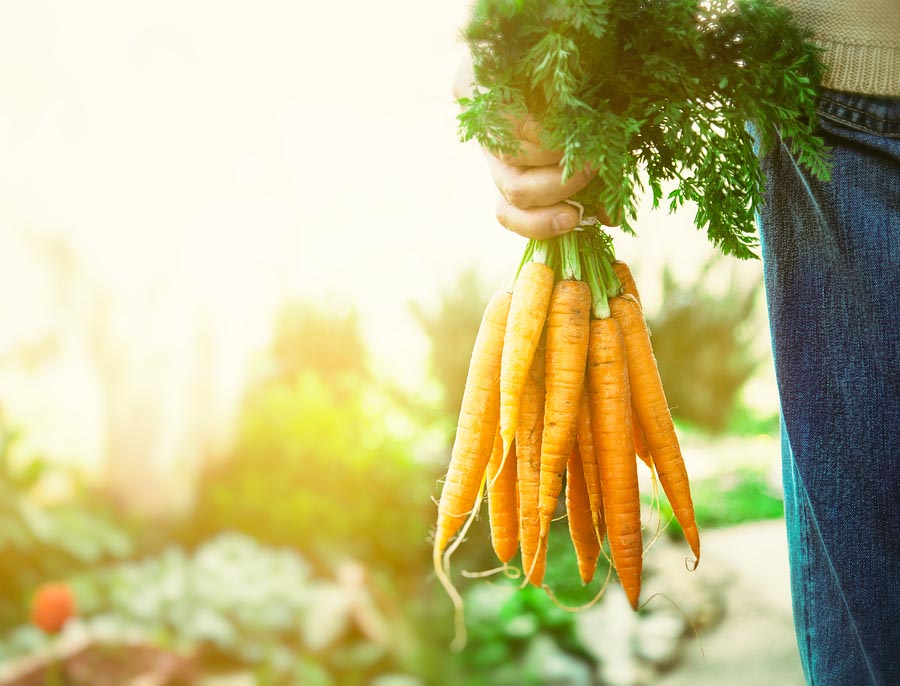

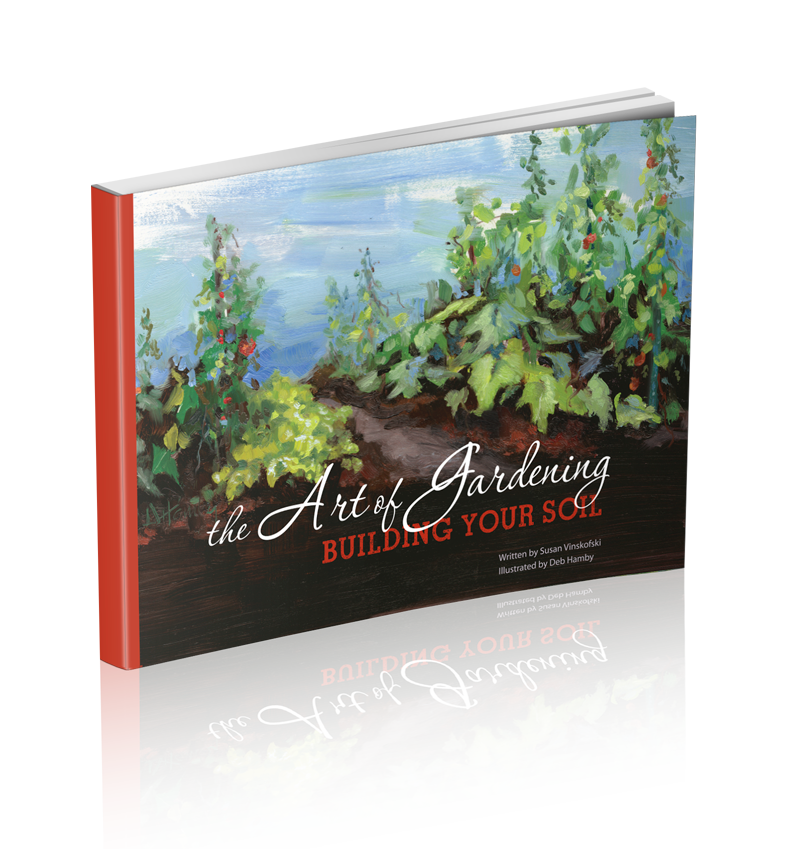
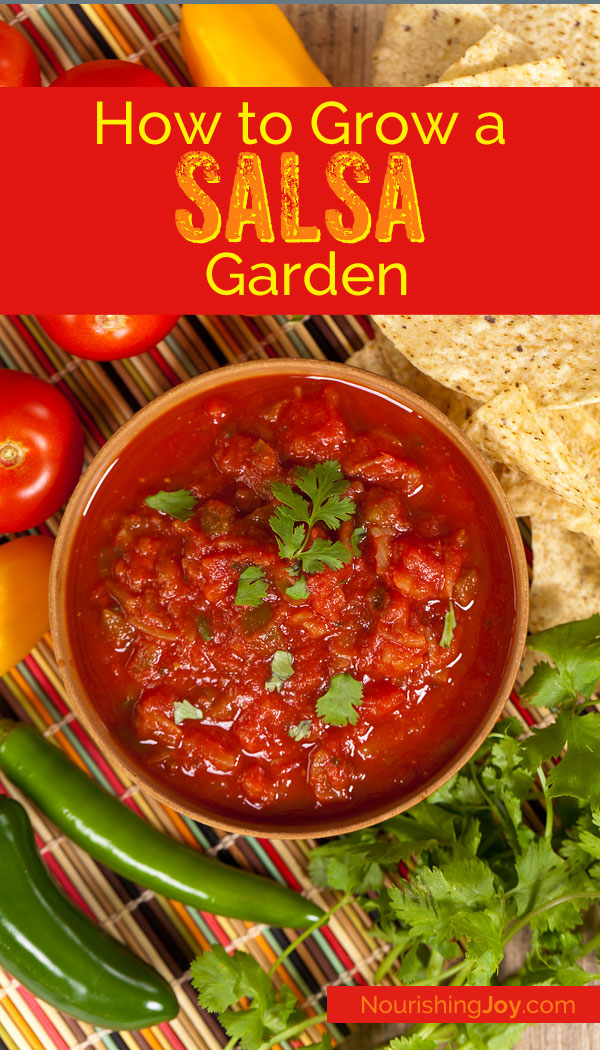

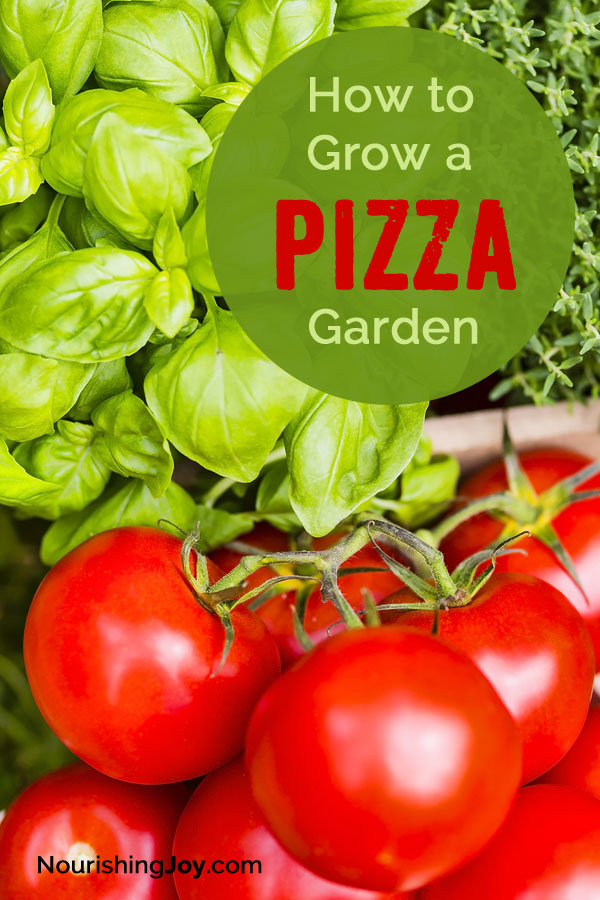
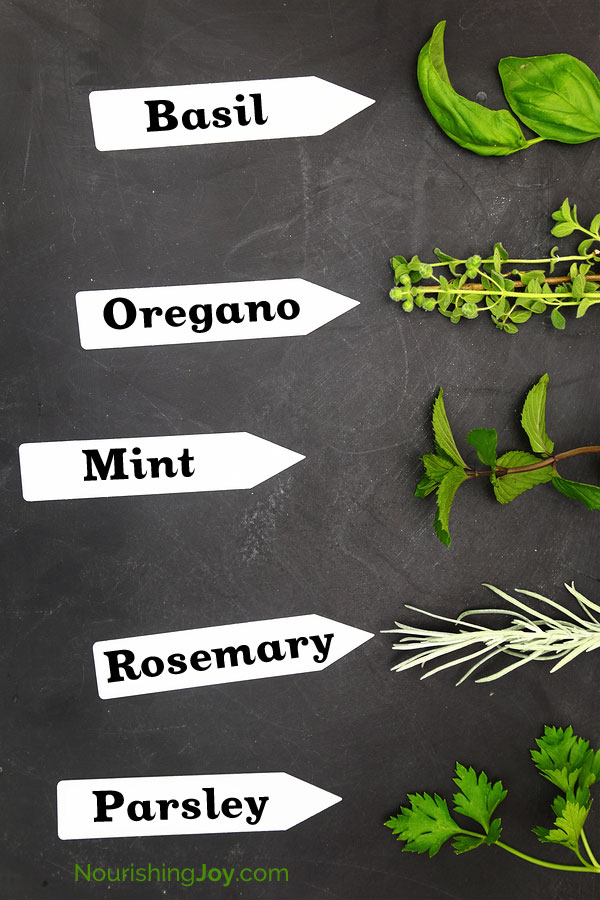
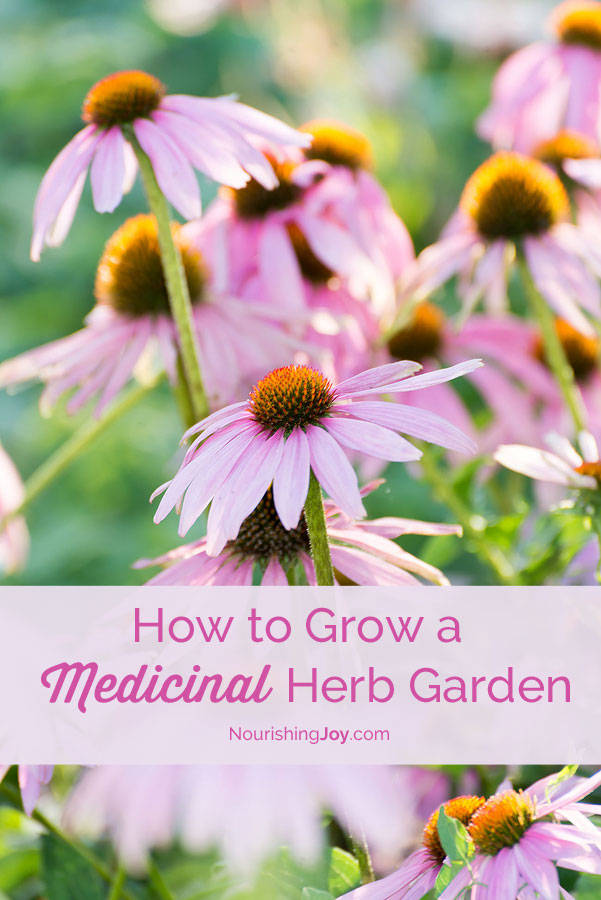
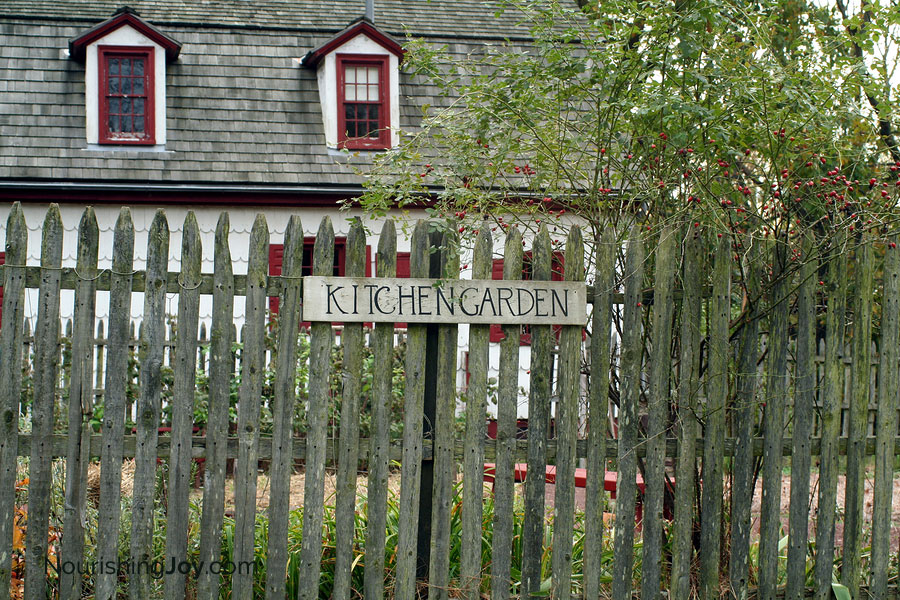
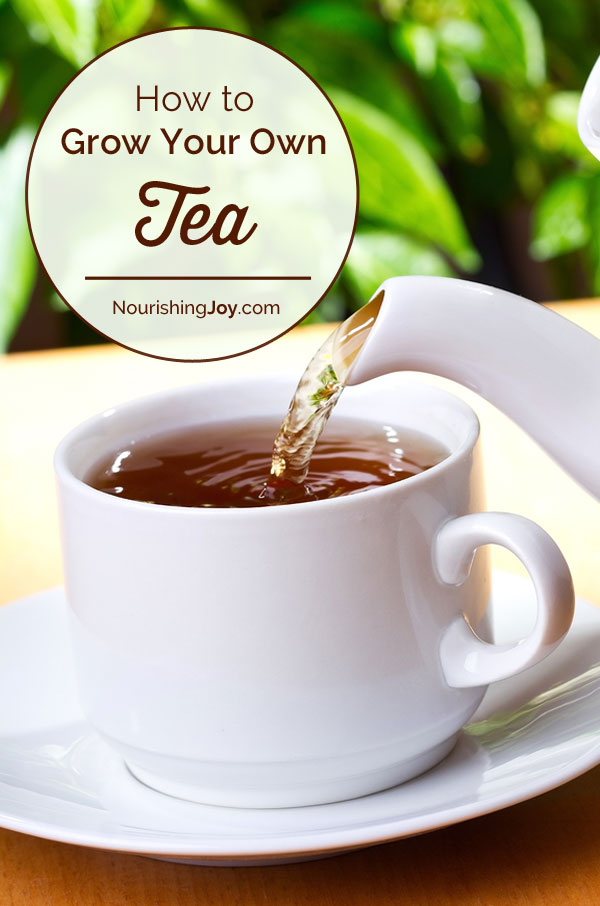
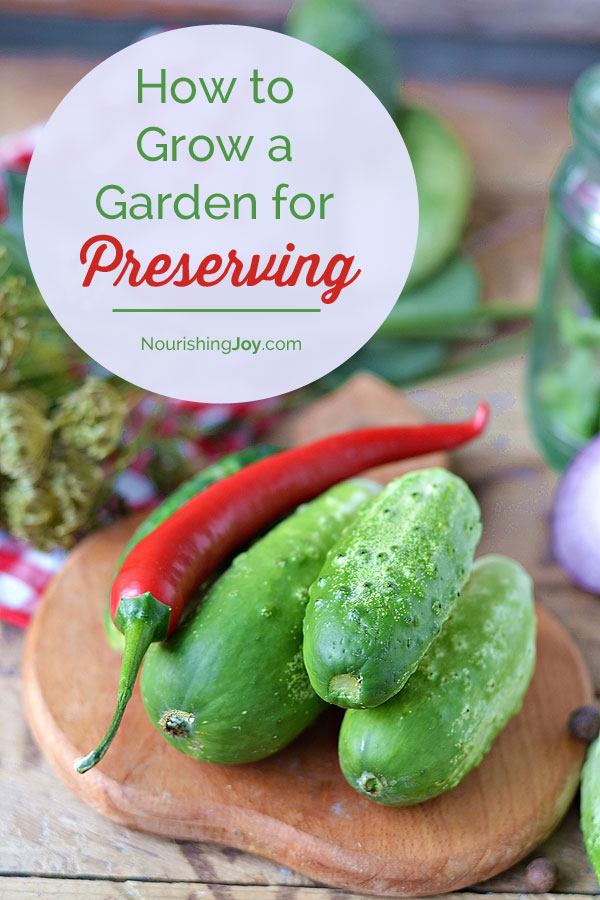
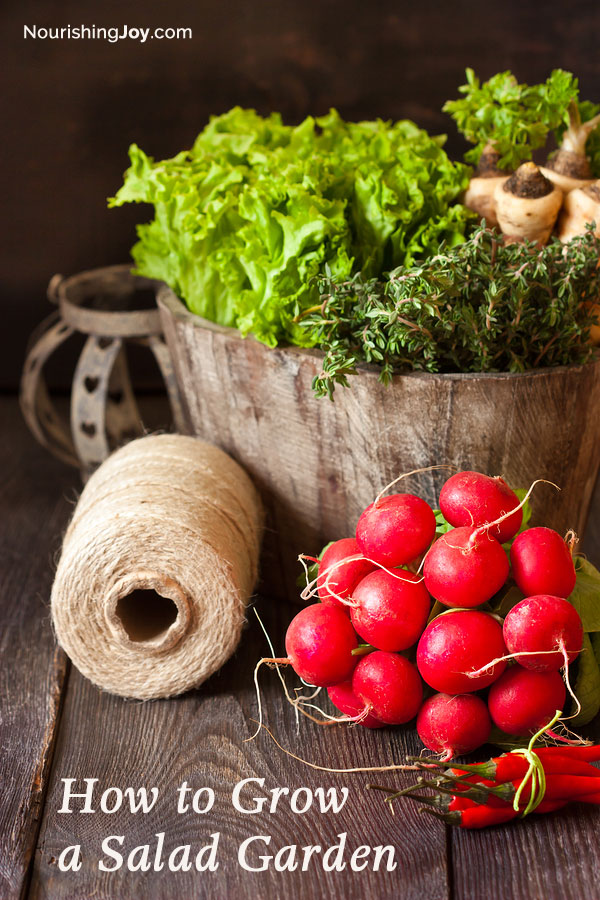
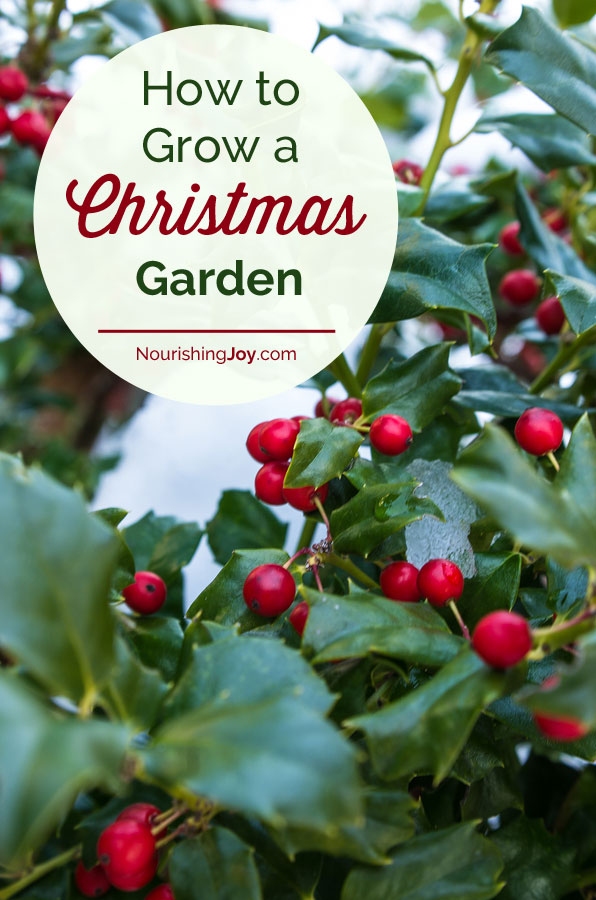



Awesome post.
I would love to plant a garden of perennial edibles. That’s what we’re slowly working on. We have all sorts of annuals in pots and containers (to keep them on the deck — away from wildlife), but are starting an in-the-ground garden of perennial edibles.
Do you have any suggestions? What are your favorite edibles to grow that come back year after year?
My husband in the expert in that regard! I’ll suggest he comes and leaves a few suggestions.
In the meantime, would anyone else like to chime in? Please share your favorites!
We have lettuce that comes back every year, you just have to let some of it go to seed.
Kresha, thank you for another excellent post. My head is full of wonderful plans for gardening. Thanks!
Oh, yay! You’re so welcome. 🙂
Loved your article!! Pinning!
Side note- No disrespect meant at all, but, omgosh for the love of all that’s Holy please don’t ever plant mistletoe!! The stuff is like tree cancer. The birds eat the seeds, then roost in trees and poop the seeds out. The seeds root right into the trees and suck the life out of them and kill them. HORRIBLE stuff! We’re losing huge old trees left and right because of mistletoe 🙁
Brilliant idea. I’ve recommended this page to my Facebook followers.
Thank you for this! I love visuals and lists and like to dream of my one day garden. I have a small container garden but I like to imagine my own tea garden and spice garden and now I’ve added a Christmas garden!
I did research Rooibos once and found out that Rooibos does not grow outside of South Africa. Attempts have been made in China and the states and they just die. It’s one of those plants that will not grow outside of it’s native land. 🙁
Thanks for that! Boy, do I wish I would grow elsewhere – it’s SUCH a great plant! 🙂
this was the BEST example of gardening. thank you for ALL THE DETAILS. Really liked how you put EVERYTHING into categories. the videos were also very helpful…I’;; be using this over & over again.